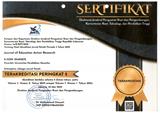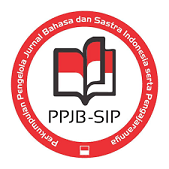Kesantunan Linguistik dan Kesantunan Pragmatik pada Tuturan Imperatif dalam Ranah Keluarga Penutur Bahasa Melayu Loloan
DOI:
https://doi.org/10.23887/jjpbs.v5i3.8678Abstrak
Penelitian ini bertujuan untuk mendeskripsikan kesantunan linguistik dan kesantunan pragmatik pada tuturan imperatif dalam ranah keluarga penutur bahasa Melayu Loloan. Subjek penelitian adalah seluruh anggota keluarga penutur bahasa Melayu Loloan di lingkungan Kelurahan Loloan Timur, Jembrana. Objek penelitian ini ialah (1) kesantunan linguistik pada tuturan imperatif bahasa Melayu Loloan dan (2) kesantunan pragmatik pada tuturan imperatif bahasa Melayu Loloan. Peneliatian ini dirancang menggunakan penelitian deskriptif kualitatif. Metode yang digunakan ialah metode observasi dan dokumentasi. Hasil dari penelitian menunjukkan bahwa: (1) Kesantunan Linguistik pada tuturan imperatif dalam ranah keluarga penutur bahasa Melayu Loloan dimarkahi oleh beberapa unsur, seperti panjang-pendek tuturan, urutan tuturan (terdapat informasi nonimperatif), intonasi tuturan, isyarat-isyarat kinesik, penanda kesantunan, dan pilihan kata yang tidak kasar. (2) Kesantunan Pragmatik pada tuturan imperatif dalam ranah keluarga penutur bahasa Melayu Loloan berdasarkan prinsip-prinsip kesantunan telah menggunakan enam maksim kesantunan, yaitu maksim kearifan/kebijaksanaan (tact maxim), maksim kedermawanan (generosity maxim), maksim peghargaan/pujian (approbation maxim), maksim kerendahan hati (modesty maxim), maksim kesimpatisan (sympath maxim), maksim kemufakatan (agreement maxim). Kesantunan pragmatik berdasarkan konstruksi tuturannya ditemukan tuturan imperatif dalam konstruksi deklaratif yang menyatakan makna pragmatik suruhan, ajakan, permohonan, dan larangan. Kemudian tuturan imperatif yang berkonstruksi interogatif yang menyatakan makna perintah, ajakan, permohonan, dan larangan. (3) Berdasarkan dua wujud kesantunan imperatif, penutur bahasa Melayu Loloan paling banyak mengguanakan tuturan imperatif berkategori cukup santun.Kata Kunci : Kesantunan Linguistik, Kesantunan Pragmatik, Tuturan Imperatif
This research aimed at describing linguistics politeness and pragmatics politeness of imperative utterances spoken by families which are native speakers of Melayu Loloan dialect. The subjects of this study were the entire family members of native speakers in Loloan Timur domain. The objects of this study were (1) linguistics politeness of imperative utterances in Melayu Loloan dialect, and (2) pragmatics politeness of imperative utterances in Melayu Loloan dialect. This research was designed in descriptive qualitative research design. In this research, the writer obtained the data through observation and documentation method. As the result of this study, it is found that (1) Linguistics politeness of imperative utterances spoken by families which are native speakers of Melayu Loloan dialect are noted by some elements, namely the long of utterances, the arrangement of the utterances (there are information of non-imperative utterances), the intonation of the utterances, kinesthetic signs, politeness marker, and the use of polite dictions. (2) Pragmatics politeness of imperative utterances spoken by families which are native speakers of Melayu Loloan dialect use six kind of politeness maxims, namely tact maxim, generosity maxim, approbation maxim, modesty maxim, sympathy maxim, and agreement maxim. Based on the utterances’ construction, pragmatics politeness appears in imperative utterances which have declarative construction and convey pragmatics meaning of command, invitation, request, and prohibition. Meanwhile, imperative utterances which have interrogative construction convey the meaning of command, invitation, request, and prohibition. (3) Based on two kinds of imperative politeness, the native speakers of Melayu Loloan dialect mostly use imperative utterances which are categorized as polite.
keyword : Linguistics Politeness, Pragmatics Politeness, Imperative Utterance
Diterbitkan
2016-11-02
Terbitan
Bagian
Articles
Lisensi
Authors who publish with the Jurnal Pendidikan Bahasa dan Sastra Indonesia Undiksha agree to the following terms:- Authors retain copyright and grant the journal the right of first publication with the work simultaneously licensed under a Creative Commons Attribution License (CC BY-SA 4.0) that allows others to share the work with an acknowledgment of the work's authorship and initial publication in this journal
- Authors are able to enter into separate, additional contractual arrangements for the non-exclusive distribution of the journal's published version of the work (e.g., post it to an institutional repository or publish it in a book), with an acknowledgment of its initial publication in this journal.
- Authors are permitted and encouraged to post their work online (e.g., in institutional repositories or on their website) prior to and during the submission process, as it can lead to productive exchanges, as well as earlier and greater citation of published work. (See The Effect of Open Access)







